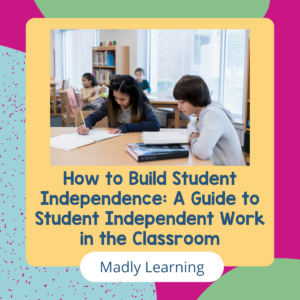Starting your teaching journey can be overwhelming, but with the right strategies, you can set yourself up for success. This post, adapted from a conversation with Dr. Lori Friesen, offers practical advice on planning, assessment, and parent communication. While this post is geared towards new teachers, any teacher can benefit from the tips Lori has to offer! It is the second part of the interview – you can find part 1 here: How To Prepare For a New Year.

Effective Planning for New Teachers
1. Create a Planning Binder
Before the school year begins, set up a comprehensive planning binder. Whether digital or physical, your binder should include:
- Weekly Lesson Plan Template: A ready-to-fill template that can be duplicated for efficiency.
- Resource Sections: Include sections for first name checklists, scholastic book orders, hot lunch forms, and other essential resources.
- Master Calendar: A calendar that encompasses all your important dates and deadlines, both digital and physical versions can be useful.
- Scope and Sequence Plans: Pre-made plans for each subject that reflect the curriculum and standards.
2. Develop a Student Data Binder
Organizing and tracking student data is crucial. A student data binder will help you manage and analyze student performance effectively. This binder should include:
- Assessment Records: Track formative and summative assessments.
- IEP Documentation: Keep individual education plans and related notes organized.
- Parent Communication Logs: Record interactions with parents regarding student progress.
Streamlined Assessment for New Teachers
1. Formative Assessments
80% of classroom activities should be practice. Use formative assessments to guide your instruction and reduce the pressure on students.
- Exit Tickets and Quizzes: Use short, frequent assessments like true/false or multiple-choice quizzes to gauge understanding.
- Completion and Effort Marks: Recognize student effort with simple marks for completion, encouraging practice without the stress of grading.
2. Summative Assessments
Summative assessments should be strategically planned and used to inform your final grades.
- Unit Tests and Projects: Include one or two quizzes, a unit test, and a significant project or group work for each unit.
- Multiple Evidence Sources: Gather two or three pieces of evidence for each standard to ensure a comprehensive evaluation.
Parent Communication Tips for New Teachers
1. Establish Clear Communication Channels
Proactive and consistent communication with parents can prevent misunderstandings and build a supportive classroom community.
- Daily Notes or Dojo: Implement a system for daily communication, such as a home communication notebook or a digital tool like ClassDojo.
- Weekly Updates: Provide weekly updates on student progress and classroom activities.
- Monthly Newsletters: Send out a newsletter each month to inform parents about upcoming events, curriculum highlights, and important dates.
2. Positive News
Balance out communication with positive news to build a strong relationship with parents.
- Celebratory Calls or Notes: Regularly share positive news about student achievements.
- Recognition Programs: Implement programs like positivity bracelets or certificates to acknowledge and celebrate student success.
Building Strong Relationships
1. Genuine Connections
Invest time in building genuine connections with your students. Understanding their interests and incorporating them into your teaching can enhance engagement and learning.
- Interest Inventories: Use interest inventories to learn about your students’ likes and dislikes.
- Class Jobs and Responsibilities: Empower students by giving them meaningful responsibilities in the classroom.
2. Preventing Apathy
Post-COVID, student engagement can be challenging. Strategies to counter apathy include:
- Social and Emotional Learning (SEL): Integrate SEL activities to help students develop essential skills.
- Consistency and Boundaries: Establish clear, consistent boundaries and routines to create a predictable and safe learning environment.
3. Managing Mental Health
Protect your own mental health by setting clear boundaries between work and personal life.
- Office Hours: Clearly communicate your availability to parents and students.
- Self-Care Practices: Prioritize self-care and maintain a healthy work-life balance.
Final Thoughts for New Teachers
Remember, as a new teacher, give yourself grace. You’re learning and growing, and it’s okay to make mistakes. Build a supportive community around you, and don’t hesitate to seek help and advice. For more in-depth strategies and support, check out Dr. Lori Friesen’s book, “Dear New Teacher: Here’s Exactly What to Do,” available on Amazon and Kindle.
For additional resources and support, visit Dr. Lori Friesen’s website or follow her on social media.
Stay positive, stay proactive, and remember, you’re making a difference every day!






